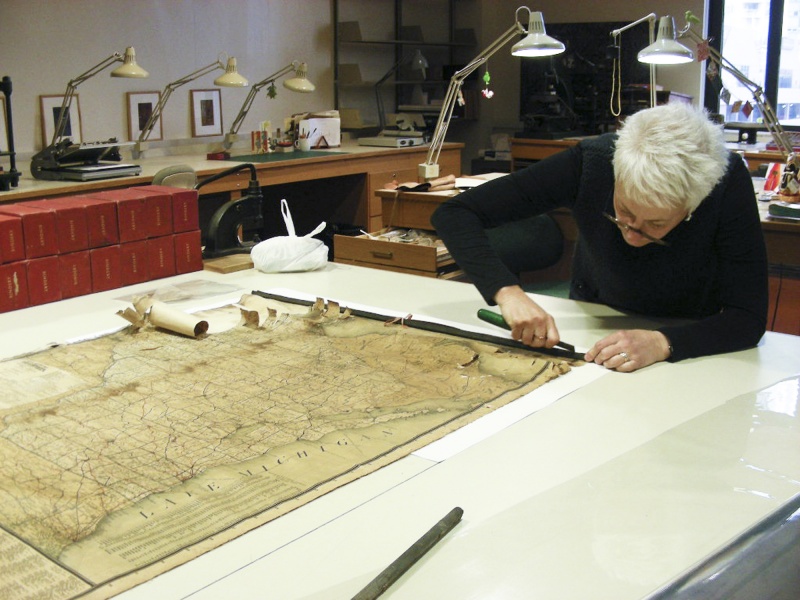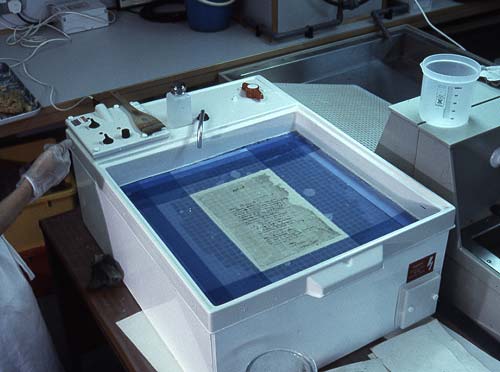Those of us who collect antique maps and prints are attracted to the field for a variety of reasons. Chief among them is the awe we feel when holding a graphic historical record that has survived for hundreds of years. Once the item enters our collection, its continued survival becomes our responsibility. Just as libraries and museums regularly review the preservation plans for their collections, collectors must also take steps to preserve and conserve their own historical artifacts for generations to come.
 The first question regarding a collection is which pieces need restoration, and which ones simply require preservation in their current state. Restoration should be considered for items for which the rate of deterioration can be slowed as well as for those for which the present condition can be substantially improved. The Conservation Center for Art & Historic Artifacts (CCAHA) has developed conservation treatment priority categories to help institutions and individuals determine when and if restoration work should be initiated. "Urgent" items are those that are unsafe to handle due to severe flaws, including extremely brittle paper, the presence of active mold or mildew, or items damaged by fire or flood. Another category includes "serious but not urgent" items that are in jeopardy of becoming damaged, such as those with acidic backing or mounts from old framing, long tears, or adhesives or tapes that cause discoloration. Click here for the full list and description of CCAHA treatment categories. The first question regarding a collection is which pieces need restoration, and which ones simply require preservation in their current state. Restoration should be considered for items for which the rate of deterioration can be slowed as well as for those for which the present condition can be substantially improved. The Conservation Center for Art & Historic Artifacts (CCAHA) has developed conservation treatment priority categories to help institutions and individuals determine when and if restoration work should be initiated. "Urgent" items are those that are unsafe to handle due to severe flaws, including extremely brittle paper, the presence of active mold or mildew, or items damaged by fire or flood. Another category includes "serious but not urgent" items that are in jeopardy of becoming damaged, such as those with acidic backing or mounts from old framing, long tears, or adhesives or tapes that cause discoloration. Click here for the full list and description of CCAHA treatment categories.
Restoring paper can be costly if potential problems are left untreated. Sometimes, no amount of money can save them. Paper that has suffered extreme water damage or long-term exposure to acidic materials may lose its structural integrity and no longer benefit from conservation. In other instances, there are trade-offs to restoration. Hand-colored maps will lose some of their color with certain repairs, such as cleaning, stain removal, or de-acidification. One of the most common trade-offs, of course, is cost. Often the value of an antique map does not warrant the price of restoring it. This is commonly seen with 19th century maps that were produced in larger quantities on inferior quality paper, making them extremely susceptible to tears, toning, and brittleness.
 Fortunately, most tragedies can be prevented. If you notice a problem, seek the advice of a qualified paper conservator immediately. Generally small defects can be treated easily and inexpensively, if done before the paper sustains permanent damage and deterioration. Some of the most common types of restoration treatments are: repairing tears, chips, holes and separations; flattening creases; and cleaning stains or discoloration. These are often some of the least expensive repairs to make, depending on the size of the map and the severity of the condition. Flattening a map or basic cleaning will cost around $100 for a folio-sized map, although if there are other issues, such as tears or localized stains, the cost will increase. The cost of repairing tears or holes depends on the repair method, with minimally invasive techniques (heat-set tissue or gummed adhesive tape) often costing less than $100. On the other hand, the leaf casting method, in which a slurry of beaten paper fibers and water is used to fill in areas of weakness, has a higher set-up cost and will usually run over $150. Adding a backing, such as Japanese tissue, to stabilize cracks, separations, or weakness in the paper costs around $150-200 for a folio-sized map. On the other hand, removing a backing is much more complicated and costly, depending on the type of adhesive used. The most expensive types of maps to repair are those that require extensive tape removal (especially if the tape is degraded) and those that are linen backed or varnished, which may have to be removed prior to making any repairs, and can bring the cost into the thousands. Fortunately, most tragedies can be prevented. If you notice a problem, seek the advice of a qualified paper conservator immediately. Generally small defects can be treated easily and inexpensively, if done before the paper sustains permanent damage and deterioration. Some of the most common types of restoration treatments are: repairing tears, chips, holes and separations; flattening creases; and cleaning stains or discoloration. These are often some of the least expensive repairs to make, depending on the size of the map and the severity of the condition. Flattening a map or basic cleaning will cost around $100 for a folio-sized map, although if there are other issues, such as tears or localized stains, the cost will increase. The cost of repairing tears or holes depends on the repair method, with minimally invasive techniques (heat-set tissue or gummed adhesive tape) often costing less than $100. On the other hand, the leaf casting method, in which a slurry of beaten paper fibers and water is used to fill in areas of weakness, has a higher set-up cost and will usually run over $150. Adding a backing, such as Japanese tissue, to stabilize cracks, separations, or weakness in the paper costs around $150-200 for a folio-sized map. On the other hand, removing a backing is much more complicated and costly, depending on the type of adhesive used. The most expensive types of maps to repair are those that require extensive tape removal (especially if the tape is degraded) and those that are linen backed or varnished, which may have to be removed prior to making any repairs, and can bring the cost into the thousands.
Because the cost of restoration can be so high, some collectors opt to take matters in their own hands and make some repairs themselves. However, most amateur repairs worsen the original problem or create new problems, resulting in the need for more costly restoration services. Never try to repair a valuable piece of art yourself. That said, there are some minor problems that can be handled by a cautious and informed collector. Surface soil or pencil marks in the margins or verso can be cleaned with a dry cleaning sponge (also known as a vulcanized rubber sponge) as long as the paper is not brittle or too thin. In some situations a soft eraser can be used, however over-cleaning can cause more damage than the dirt itself as it will remove the top layers of the paper and may cause a tear or hole. Do not attempt cleaning with water or solvents.
Tiny marginal tears or fold separations can be closed with special archival tape, heat-set tissue, or gummed adhesive tapes that are water activated. Tears that extend into the printed image are best left to the expertise of a conservator. Nevertheless one must be careful that the materials are suitable for antique paper and will not cause damage or discoloration over time. Unfortunately, the word "archival" is not regulated, so amateurs must be cautious about buying products marketed as such. Never repair a tear with common pressure-sensitive (Scotch) tape, because the adhesive will yellow and permanently stain paper. Heat-set tissue is the most preferable material to use, as it is easier to remove. If further restoration work is required on the map, the conservator may have to remove any archival tape before other repairs, such as cleaning, can be performed.
We are the temporary custodians of the items in our collection. If we do not take proper steps to preserve our collections they will be lost to the ravages of time. With the advances made in the world of art and paper conservation over the last 30 years, the resources to restore antique maps are now available to collectors everywhere.
For more information on preservation and conservation:
Library of Congress
Conservation Center for Art & Historic Artifacts (CCAHA)
National Archives and Records Administration
American Institute for Conservation of Historic & Artistic Works (AIC)
For a listing of conservators in your area, you can use AIC's online conservator search tool. | | | | |